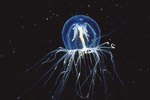
Jellyfish are extremely simple organisms. They are 95 percent water and have the most basic nerve system of any multicellular organism. A typical jellyfish is composed of two structures: an external epidermis and an internal gastrodermis. This forms the bell, from which the tentacles flow. Although jellyfish are mainly water, they do have nerves, reproductive cells and muscle. The muscle is key to short-distance propulsion.
Muscle-Powered Propulsion
All jellyfish have a ring of muscle that encircles the bottom of the bell, which is the main component of the jellyfish anatomy. The bell is hollow and open-ended, allowing it to fill with water. The muscles around the bell contract, squeezing out the water and propelling the jellyfish forward, upward or downward, depending on the position of the bell at the time of compression.
Resting the Muscles
Although jellyfish use muscle to propel themselves short distances, much of their movement is done without the use of muscle. Their travel is governed by the currents of the water, which move them along. This is why the movement of jellyfish populations can be quite easily predicted, as they tend to drift in the same direction as the current. Their muscle-powered propulsion is not strong enough to override the current's power.
Muscles Making History
Jellyfish are believed to be the first creatures in the history of evolution to use muscles for swimming. Prior to the evolution of propulsion muscles, all sea creatures achieved movement by drifting with the currents. This adaptation is estimated to have occurred more than 700 million years ago, long before dinosaurs existed. In fact, jellyfish are among the oldest life forms on Earth. They are approximately three times as old as the first dinosaurs.
Coiled Springs
The stinging barbs that festoon a jellyfish’s tentacles enable it to kill prey and deter predators. The stinging mechanism is one of the more complex functions of the jellyfish anatomy, but it is completely muscle-free, despite relying on quick movement to serve its purpose. Rather than muscle-powered movement, which is how venomous snakes move their jaws to inject venom, the jellyfish uses coiled springs that trigger a harpoon-like stinger into motion when touched.
References
Photo Credits
-
Jupiterimages/Photos.com/Getty Images
Writer Bio
Simon Foden has been a freelance writer and editor since 1999. He began his writing career after graduating with a Bachelors of Arts degree in music from Salford University. He has contributed to and written for various magazines including "K9 Magazine" and "Pet Friendly Magazine." He has also written for Dogmagazine.net.



